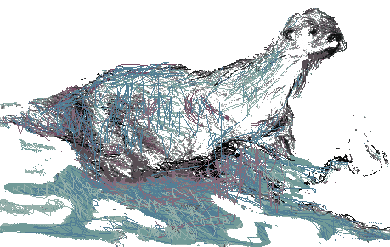

That's why it doesn't seem possible to me to separate questions about the forms of art from my interest in memory and time: the biographical subject matter is a way of talking about form. My earliest exploration of autobiographical materials were paintings based on family photos, but I found myself straying from my initial impulse, which was to reconstruct the past. I began to make paintings in which there was some awareness of photographs as forms, as fragmentary conveyors of information. They are not only fragments of light torn out of the darkness of time, preservers of the past, they are blackened grains of silver open to infinite interpretation in the darkroom, and the closer you try to get to them, the less you see: ultimately, theirs is a universe of black meteorites, random and incomprehensible.
Eventually, I found my metaphor for the fragmentary nature of images, and of our attempts to understand our world through images, in the idea of reprocessing. This resulted in multi-paneled works in which images from various sources are re-photographed and re-presented or photographs themselves re-presented in other techniques and often again re-photographed.
Computers are the ultimate tool for reprocessing of images. For instance, the Web site which is part of Autobiography enables the viewer to zoom in on images, to rotate them, flip them, etc. The computer provides a new way of saying that images are fluid, unfixed, and fragmentary. For, its images consist not of physical data, grains of silver or pen strokes, but of digitized information, codes representing states of electrical current. The malleability of computerized data is built into the World Wide Web, where different computers represent the same material differently, depending on the equipment and the Web software used. Autobiography emphasizes this malleability by displaying the same data on two computers. One accesses the Web, and one does not, using instead software which I developed myself. My point here is that there is no one fixed inevitable form for a work, just as there is no one version of an image. Forms, images, memories, our own self-understanding, all are subject to repeated revision and reinterpretation. And here the World Wide Web is a fundamentally contemporary form, because a web site consists in the process; it develops as its parts are ready to be posted, and is under continuous review and revision.
Sea-Changes is an extension of these ideas. It, too, is about reprocessing, but here it is each individual artist who is reprocessing the biographies of the other artists taking part in the project. And each created "biography" is one way of looking at the same body of material, for which, again, there is no one fixed inevitable form and no one version but is instead open to repeated revision and reinterpretation. Finally, what is created in each instance is like all memory and all art: each biography is both real and unreal: it is a "truth" because created out of true materials and yet a fiction because this truth, perhaps like all truth, is ours only through the power of imagination.
Myron Turner